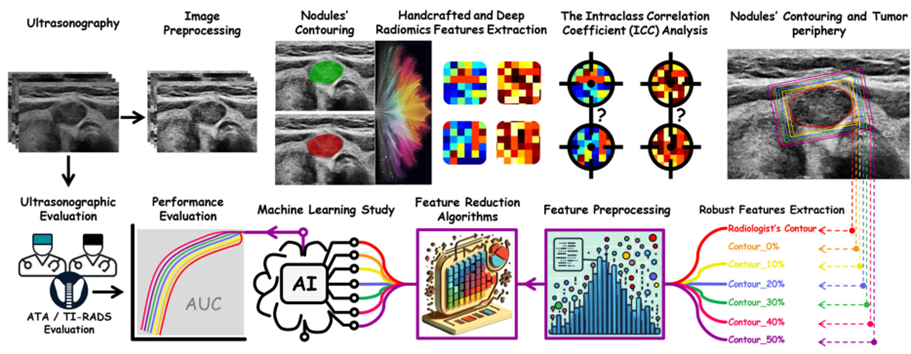Abstract
Objective—To develop, test, and externally validate a hybrid artificial intelligence (AI) model based on hand-crafted and deep radiomics features extracted from B-mode ultrasound images in differentiating benign and malignant thyroid nodules compared to senior and junior radiologists. Methods—A total of 1602 thyroid nodules from four centers across two countries (Iran and Malaysia) were included for the development and validation of AI models. From each original and expanded contour, which included the peritumoral region, 2060 handcrafted and 1024 deep radiomics features were extracted to assess the effectiveness of the peritumoral region in the AI diagnosis profile. The performance of four algorithms, namely, support vector machine with linear (SVM_lin) and radial basis function (SVM_RBF) kernels, logistic regression, and K-nearest neighbor, was evaluated. The diagnostic performance of the proposed AI model was compared with two radiologists based on the American Thyroid Association (ATA) and the Thyroid Imaging Reporting & Data System (TI-RADS™) guidelines to show the model’s applicability in clinical routines. Results—Thirty-five hand-crafted and 36 deep radiomics features were considered for model development. In the training step, SVM_RBF and SVM_lin showed the best results when rectangular contours 40% greater than the original contours were used for both hand-crafted and deep features. Ensemble-learning with SVM_RBF and SVM_lin obtained AUC of 0.954, 0.949, 0.932, and 0.921 in internal and external validations of the Iran cohort and Malaysia cohorts 1 and 2, respectively, and outperformed both radiologists. Conclusion—The proposed AI model trained on nodule+the peripheral region performed optimally in external validations and outperformed the radiologists using the ATA and TI-RADS guidelines.

FIGURE 1 Graphical abstract of the study delineating the study phases.

